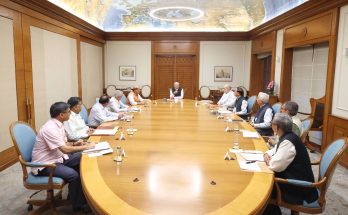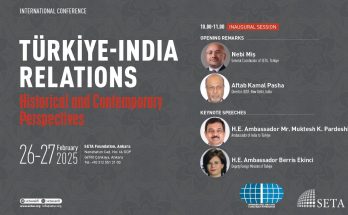 South Asia followed India’s May 2014 parliamentary election with great curiosity. While many were apprehensive about the new government’s regional policy, the diplomatic masterstroke of inviting leaders of South Asian nations to the swearing-in ceremony of India’s Prime Minister Narendra Modi was seen as a welcome surprise. The new leadership in Delhi has said that South Asia will be central in its foreign policy calculus. This “neighbourhood first” approach was reflected in Mr Modi’s visit to Bhutan and Nepal within the first few months of assuming office, and his announcement that India will develop a satellite for the benefit of all SAARC nations.
South Asia followed India’s May 2014 parliamentary election with great curiosity. While many were apprehensive about the new government’s regional policy, the diplomatic masterstroke of inviting leaders of South Asian nations to the swearing-in ceremony of India’s Prime Minister Narendra Modi was seen as a welcome surprise. The new leadership in Delhi has said that South Asia will be central in its foreign policy calculus. This “neighbourhood first” approach was reflected in Mr Modi’s visit to Bhutan and Nepal within the first few months of assuming office, and his announcement that India will develop a satellite for the benefit of all SAARC nations.
New Delhi’s pro-active approach towards its neighbours has raised hopes that the idea of South Asian regional cooperation may once again find itself in the spotlight.
Triumph of hope over cynicism
In the last two decades, South Asian Association for Regional Cooperation (SAARC) has stalled on the implementation of numerous declarations made during summits. However, one initiative that has borne fruit is the establishment of South Asian University (SAU): a one-of-its-kind regional university that is democratically and financially partnered by the eight member states of SAARC in common pursuit of knowledge for regional and human advancement.
In November 2005, at the 13th SAARC Head of States meeting in Dhaka, India’s then Prime Minister Manmohan Singh raised the idea of establishing a ‘Center of Excellence’ in form of a university. “Let this become a forum where our academicians, scholars, researchers and gifted students can work together in the service of human advancement.”
By 2010-11, the first academic session had begun, and the SAU enrolled 14 non-Indian students. In the last few years the university has enhanced its reach and profile. The common entrance exam for Academic Session, 2014-15, conducted simultaneously in 17 centers in eight member states, brought in 4637 applicants for its Masters and Doctorate Programmes: including 538 applications of non-Indian students (168 from Afghanistan; 155 from Bangladesh; 14 from Bhutan; 4 from Maldives; 98 from Nepal; 73 from Pakistan; and 26 from Sri Lanka). 4099 students from India applied.
The around 250 seats on offer are divided among member states; with no more than 50% of the seats reserved for Indian students in any class.
South Asian perspective
 At SAU, the focus is on inculcating the feeling of ‘South Asian-ness’ among students. Since 2013, SAU has introduced a compulsory course entitled ‘Introduction to South Asia’, an inter-disciplinary course that exposes students to the diversity, challenges and opportunities of the region.
At SAU, the focus is on inculcating the feeling of ‘South Asian-ness’ among students. Since 2013, SAU has introduced a compulsory course entitled ‘Introduction to South Asia’, an inter-disciplinary course that exposes students to the diversity, challenges and opportunities of the region.
It is quite a sight to see students so often separated by cultural differentness finally find a live space where they can discuss their fears, hopes and aspirations over endless cups of tea.
One of the most celebrated evenings of the year is the night of August 14-15, when students from Pakistan and India, along with those from other nations, come together to sing patriotic songs, perform dances and skits, make passionate speeches and eat good food. And all this is done in the spirit of confident nationalism, one that does not rely on disparaging the other.
SAU also organises a number of international and regional conferences to bring alive the South Asian perspective. In October 2013, the Faculty of Social Sciences organised an international conference: Changing Scenario in Afghanistan: Implication for South Asia. The objective of the conference was to debate and provide policy recommendations in view of the NATO’s troop’s withdrawal from Afghanistan by the end of 2014, and the possible roles for South Asian countries.
Similarly in March 2014, the university, organised a regional conference: United Nations Peace Keeping: South Asian Perspective. “Our aim is to develop a vocabulary that can articulate – in organic terms – the participation of South Asian countries in United Nations peacekeeping, and also offer regional perspectives on international peace and security,” Soumita Basu, Assistant Professor at the Department of International Relations, told www.indiawrites.org.
Academics at AU actively seeks to train students to think, research and promote viewpoints that are indigenous to the region –- to escape the confines of West-centric intellectual traditions.
Appeal for students
In addition to the diversity and vision, the impressive student faculty ratio has also contributed to the university’s growing popularity. For Muqadar Hashimi, a recent graduate from Afghanistan, “The small class size of around 30 students and around 8 faculty members per department provides a great opportunity to interact with the teachers.”
International students are also attracted by liberal scholarships made available by the university. In 2013-14, 269 of the 272 students who applied for scholarship/financial aid were granted, partial or full, financial assistance. This includes the 100 Government of India Silver Jubilee Scholarships, which comprises full tuition waiver, full hostel rent waiver, plus a living allowance.
The Way Ahead
But not all are convinced about the reasonableness of the idea of SAU, or its implementation. India currently shoulders most of the responsibility. The capital cost, approximately 300 million USD, for the first phase (2010-2014), is to be completely borne by the Government of India. The operational cost, however, is shared on a yearly basis, by all SAARC members. There are also visa issues: students who are given special single-entry SAU visas to study in New Delhi cannot travel to other member states, seriously limiting enhanced people-to-people contact.
Another cause of concern for SAU is the lack of diversity among its faculty. Only 10 percent of the teaching staff is non-Indian, and more must be done to recruit quality educators from other nations.
But the main obstacle that haunts South Asia, and thus South Asian University, is the amorphous idea of South Asia itself. Divided into territorial nations, the idea of South Asia and ‘South Asian-ness’ appears vague. But Professor Rajen Harshe, visiting Professor at the Department of International Relations, feels that the time has come to actualize the idea of South Asia. “We need the idea of South Asia for its philosophical and spiritual aspects first, commercial and economic rationales follow later,” Prof. Harshe told India Writes Network (www.indiawrites.org).
In spite of these growing pains, SAU represents a positive step forward in regionalism. By training future leaders and decision-makers the university is putting in place a trans-regional network of students that will provide much needed impetus for enhanced cooperation and cultural commingling in the region. More than a university, SAU is an idea, which the leaders of South Asia must continue to firmly stand behind and proactively encourage its expansion and outreach.
Author Profile
- India Writes Network (www.indiawrites.org) is an emerging think tank and a media-publishing company focused on international affairs & the India Story. Centre for Global India Insights is the research arm of India Writes Network. To subscribe to India and the World, write to editor@indiawrites.org. A venture of TGII Media Private Limited, a leading media, publishing and consultancy company, IWN has carved a niche for balanced and exhaustive reporting and analysis of international affairs. Eminent personalities, politicians, diplomats, authors, strategy gurus and news-makers have contributed to India Writes Network, as also “India and the World,” a magazine focused on global affairs.
Latest entries
 India and the WorldJune 26, 2025Operation Sindoor: India Sheds Restraint, Rediscovers Utility of Force
India and the WorldJune 26, 2025Operation Sindoor: India Sheds Restraint, Rediscovers Utility of Force India and the WorldJune 23, 2025BRICS summit in Rio to focus on Global South, local currency trade
India and the WorldJune 23, 2025BRICS summit in Rio to focus on Global South, local currency trade Africa InsightsJune 11, 2025New Opportunities in India-Japan Cooperation in Africa
Africa InsightsJune 11, 2025New Opportunities in India-Japan Cooperation in Africa India and the WorldMay 23, 2025Post-Operation Sindoor, India reminds Turkey, China of concerns and sensitivities
India and the WorldMay 23, 2025Post-Operation Sindoor, India reminds Turkey, China of concerns and sensitivities







